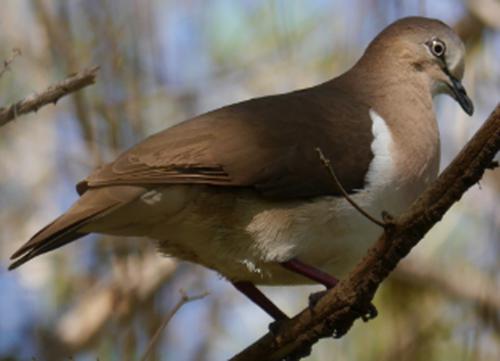当前位置:
X-MOL 学术
›
Ecol. Evol.
›
论文详情
Our official English website, www.x-mol.net, welcomes your feedback! (Note: you will need to create a separate account there.)
Non-invasive sampling reveals low mitochondrial genetic diversity for an island endemic species: The critically endangered Grenada Dove Leptotila wellsi
Ecology and Evolution ( IF 2.6 ) Pub Date : 2023-11-23 , DOI: 10.1002/ece3.10767 Catherine Peters 1 , Matthew Geary 1 , Charlotte Hosie 1 , Howard Nelson 2 , Bonnie Rusk 3 , Anna Muir 1
Ecology and Evolution ( IF 2.6 ) Pub Date : 2023-11-23 , DOI: 10.1002/ece3.10767 Catherine Peters 1 , Matthew Geary 1 , Charlotte Hosie 1 , Howard Nelson 2 , Bonnie Rusk 3 , Anna Muir 1
Affiliation

|
As an island endemic with a decreasing population, the critically endangered Grenada Dove Leptotila wellsi is threatened by accelerated loss of genetic diversity resulting from ongoing habitat fragmentation. Small, threatened populations are difficult to sample directly but advances in molecular methods mean that non-invasive samples can be used. We performed the first assessment of genetic diversity of populations of Grenada Dove by (a) assessing mtDNA genetic diversity in the only two areas of occupancy on Grenada, (b) defining the number of haplotypes present at each site and (c) evaluating evidence of isolation between sites. We used non-invasively collected samples from two locations: Mt Hartman (n = 18) and Perseverance (n = 12). DNA extraction and PCR were used to amplify 1751 bps of mtDNA from two mitochondrial markers: NADH dehydrogenase 2 (ND2) and Cytochrome b (Cyt b). Haplotype diversity (h) of 0.4, a nucleotide diversity (π) of 0.00023 and two unique haplotypes were identified within the ND2 sequences; a single haplotype was identified within the Cyt b sequences. Of the two haplotypes identified, the most common haplotype (haplotype A = 73.9%) was observed at both sites and the other (haplotype B = 26.1%) was unique to Perseverance. Our results show low mitochondrial genetic diversity and clear evidence for genetically isolated populations. The Grenada Dove needs urgent conservation action, including habitat protection and potentially augmentation of gene flow by translocation in order to increase genetic resilience and diversity with the ultimate aim of securing the long-term survival of this critically endangered species.
中文翻译:

非侵入性采样揭示了一种岛屿特有物种的线粒体遗传多样性较低:极度濒危的格林纳达斑鸠 Leptotila Wellsi
作为一个人口不断减少的岛屿特有种,极度濒危的格林纳达斑鸠Leptotila Wellsi受到栖息地持续破碎化导致遗传多样性加速丧失的威胁。小型、受威胁的种群很难直接取样,但分子方法的进步意味着可以使用非侵入性样本。我们对格林纳达斑鸠种群的遗传多样性进行了首次评估,方法是(a)评估格林纳达仅有的两个居住区域的 mtDNA 遗传多样性,(b)定义每个地点存在的单倍型数量,以及(c)评估站点之间的隔离。我们使用来自两个地点的非侵入性采集的样本:哈特曼山 ( n = 18) 和毅力山 ( n = 12)。DNA 提取和 PCR 用于从两个线粒体标记物中扩增 1751 bps 的 mtDNA:NADH 脱氢酶 2 ( ND2 ) 和细胞色素 b ( Cyt b )。在ND2序列中鉴定出单倍型多样性 ( h ) 为 0.4、核苷酸多样性 ( π ) 为 0.00023 和两个独特的单倍型;在Cyt b序列中鉴定出单一单倍型。在确定的两种单倍型中,最常见的单倍型(单倍型 A = 73.9%)在两个地点均观察到,而另一种(单倍型 B = 26.1%)是 Perseverance 所独有的。我们的结果显示线粒体遗传多样性较低,并提供了遗传隔离群体的明确证据。格林纳达斑鸠需要采取紧急保护行动,包括栖息地保护和通过易位可能增加基因流,以提高遗传弹性和多样性,最终目标是确保这一极度濒危物种的长期生存。
更新日期:2023-11-25
中文翻译:

非侵入性采样揭示了一种岛屿特有物种的线粒体遗传多样性较低:极度濒危的格林纳达斑鸠 Leptotila Wellsi
作为一个人口不断减少的岛屿特有种,极度濒危的格林纳达斑鸠Leptotila Wellsi受到栖息地持续破碎化导致遗传多样性加速丧失的威胁。小型、受威胁的种群很难直接取样,但分子方法的进步意味着可以使用非侵入性样本。我们对格林纳达斑鸠种群的遗传多样性进行了首次评估,方法是(a)评估格林纳达仅有的两个居住区域的 mtDNA 遗传多样性,(b)定义每个地点存在的单倍型数量,以及(c)评估站点之间的隔离。我们使用来自两个地点的非侵入性采集的样本:哈特曼山 ( n = 18) 和毅力山 ( n = 12)。DNA 提取和 PCR 用于从两个线粒体标记物中扩增 1751 bps 的 mtDNA:NADH 脱氢酶 2 ( ND2 ) 和细胞色素 b ( Cyt b )。在ND2序列中鉴定出单倍型多样性 ( h ) 为 0.4、核苷酸多样性 ( π ) 为 0.00023 和两个独特的单倍型;在Cyt b序列中鉴定出单一单倍型。在确定的两种单倍型中,最常见的单倍型(单倍型 A = 73.9%)在两个地点均观察到,而另一种(单倍型 B = 26.1%)是 Perseverance 所独有的。我们的结果显示线粒体遗传多样性较低,并提供了遗传隔离群体的明确证据。格林纳达斑鸠需要采取紧急保护行动,包括栖息地保护和通过易位可能增加基因流,以提高遗传弹性和多样性,最终目标是确保这一极度濒危物种的长期生存。

































 京公网安备 11010802027423号
京公网安备 11010802027423号